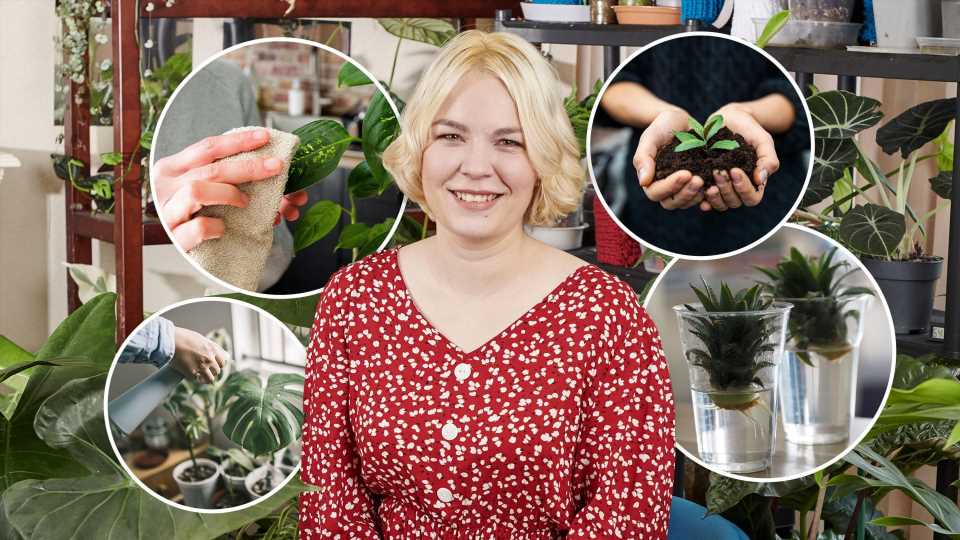CYNTHIA Vajda is so potty about her house plants she treats them like children.
The 34 year old's three-bed semi which she shares with husband Robert, 36, a tattooist, is packed full with her 200 'plant babies' and they even have their own nursery.
And Cynthia, who lives in Crawley, West Sussex, says she knows the secret to helping plants thrive: "I tend to my plants like they are my children," she explains.
"I talk to them and stroke their leaves. I believe plants thrive off our touch and communication.
“You know you’re doing a good job when they're sprouting leaves before your eyes. It’s a wonderful feeling to see how your care has helped them to grow."
Houseplants have exploded in popularity with the average Brit spending £306.71 on them annually.
READ MORE ON GARDENING

Easy ways to grow your own fruit & veg even if you don’t have garden

Five cash-saving tips to get your green space ready for summer
Celebrities including Sort Your Life Out presenter Stacey Solomon,singer Charlotte Church and diver Tom Daley have all shared their love for them.
However, making sure plants thrive year after year can be a challenge.
Here Cynthia, who works as a dispatcher,reveals how to keep your indoor greenery thriving.
USE GOOGLE LENS FOR CLUES
If you are unsure about the identity of your plant or it looks unwell, try Google Lens on your phone – it's completely free – and can be a great tool to identify the problem and get help.
Most read in Fabulous

Passion expects a lot of you, so don’t make promises you can’t keep

Experts reveal best autumn supermarket outfits including a £35 Gucci dupe

People are realising they’ve been cutting takeaway pizza wrong their whole lives

Paris Fury relives screaming ‘my baby’s dying’ as newborn fought for life
While many plant apps do the same job there can be a charge. Spotting problems this way doesn't work every time but it's a good place to start if you're trying to identify a plant problem and looking for clues on how to fix it.
DON'T DUMP AND HOPE FOR THE BEST
All plants have different needs – you can't just get a plant and dump it on a windowsill and hope for the best. When you buy a plant, research what the plants needs in terms of optimum light position. Does it like full sun? How much water does it need?Some like a good soak and others need a water only when they get dry.
CLEAR POTS TO GET TO THE ROOT OF THE PROBLEM
Looking underneath your plants can give you an indicator of how healthy your plant is. You can see if it is waterlogged or too dry – roots should be firm. If they are mushy then they are rotting.
Also look beneath to check if the roots are bursting out of the pot and if they are, the plant needs re potting in a roomier one. When I propagate new plants I always use clear pots so I can see what's going on beneath the soil.
USE THE FINGER TEST
No plants can survive without water but over watering is a common mistake.Lots of plants are lost to rotting roots from being waterlogged – under watering is better than over watering.
The most reliable indicator is to test the soil with a finger. You need to go an inch down and if the soil at that depth is dry, it's a signal to water. Failing that, a plant will tell you if it’s thirsty because its leaves will start to sag.
TOP UP SOIL
A new plant usually comes in a pot with fresh soil with bobbles of fertiliser which breaks down over time. That means you'll need to top up the soil yourself or your plant won't thrive. If you pot a plant yourself from scratch, use your hand to press firmly down on the soil and remember to not leave too much space between the top of the soil and the rim of the pot. If there's too much space, you'll end up giving the plant too much water which is damaging.
DITCH THE MISTING
Some experts recommend misting plants to create humidity to help growth but there is no need. All you are creating is a temporary humid area that stresses plants out because misting is an artificial humidifier that will only work for around an hour. Let your plants acclimatise to the room they're in and if you want to create more humidity you can do it permanently with a humidifier.
You need to find a balance that is good for you and the plants. Personally, I wouldn't bother with the mist.
ONCE A MONTH WIPE
Plants grow through the process of photosynthesis – they need sunlight to grow – which means their leaves are doing all the work. If they get dusty they can't do their job properly. You don't need to go crazy with the cleaning but gently wiping leaves with a damp cloth once a month or so should keep them happy and thriving.
CHOPPING BROWN LEAVES CAUSES BRUISING
Plants will get brown leaves from time to time. They can be a sign that they're either getting too much light, or not enough humidity. Don't give up on them the minute you see brown patches on leaves – chopping away at any brown bits will harm your plants, creating bruising, and that triggers more brown leaves. A bit of brown on the leaves is healthy so leave it – even if it means they aren't Instagram worthy.
WASHING UP LIQUID ON PESTS
Like outdoor plants, indoor ones are susceptible to pests. There is one bug called thrip that eat away at your plants and can infect all your plants if you don't keep it in order. There are expensive treatments on the market but giving them a wipe with washing up liquid, leaving it for a couple of minutes and then wiping it off, should do the trick. They can’t survive a blast of soap so use sparingly.
PROPAGATE YOUR PLANTS
Plants can grow big, even in pots, indoors. You can easily split plants or chop them down to size and use the cuttings to make more plants – therefore keeping your plants at a nice size and increasing your collection cost free.
READ MORE SUN STORIES

I'm a cleaner, 5 things I'd never put in my house – including a kitchen handle

Paris Fury shares sleepy selfie & baby update after day of 'normal life'
 7
7For most plants you can cut stems just below a bud – remove any leaves – then pop the stem into a glass of water and watch for roots to form. At that point, you can pot it in soil.
Only pot the stem in pots that are one or two sizes up from the one it was already in or again, you will end up giving it too much water.
Source: Read Full Article








